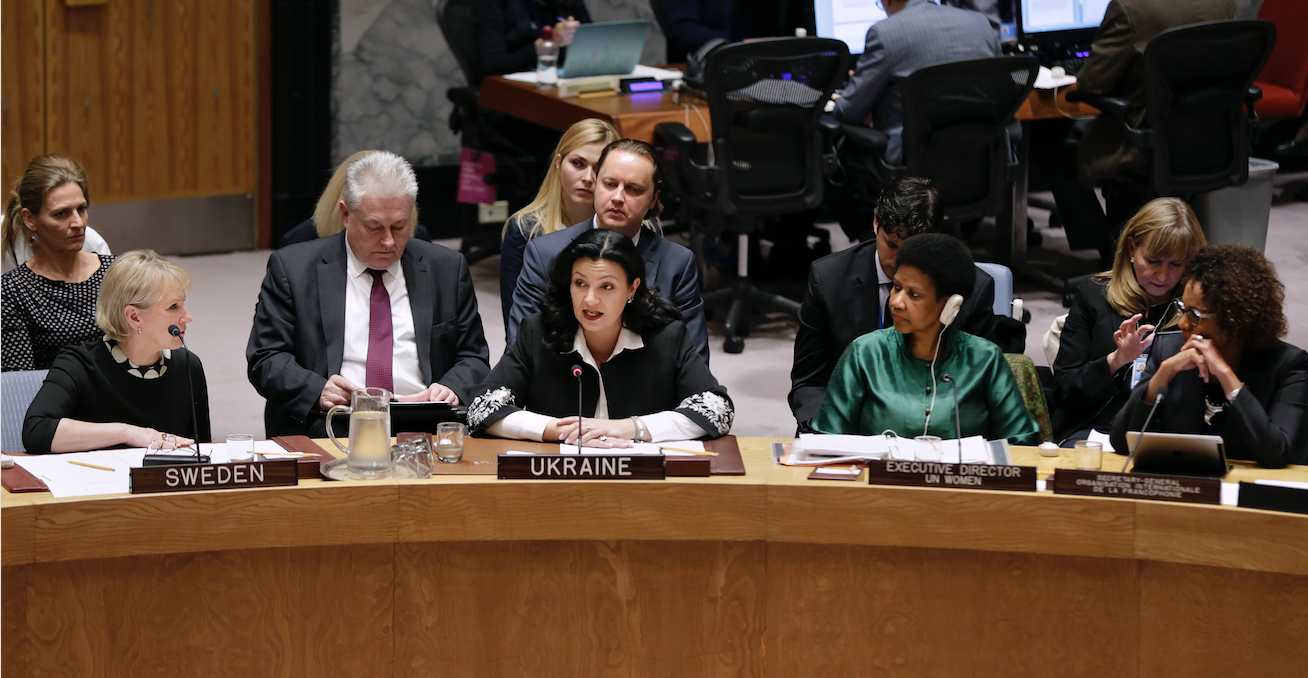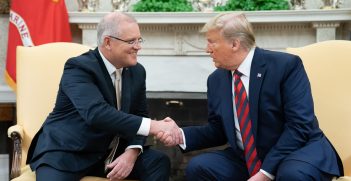The UN Women Peace and Security Agenda: Libya and Australia

Seventy years since the UN Declaration of Human Rights, there still remains a way to go in addressing the root causes of sexual violence in conflict zones such as Libya. Meanwhile, Australia has a mixed record of supporting women’s rights.
The 70th anniversary of the Universal Declaration of Human Rights (UDHR) is a momentous moment in recognition of a visionary document that set the standards for universal human rights. This declaration provides the foundation upon which other critical human rights frameworks developed, including the Women, Peace and Security (WPS) agenda within the UN Security Council.
In 2010, I co-authored a publication on behalf of Women’s International League for Peace and Freedom (WILPF), the NGO working group on WPS and Global Action for the 10th anniversary of UN Security Council Resolution (UNSCR) 1325. The publication highlighted that women face significant barriers to full participation, including: a lack of inclusive leadership; gaps between government policy and action; a fragmentation of networks and messaging; and a lack of resources and educational opportunities. However, while gaps exist, women are constantly seeking to circumvent these limitations through formulating and sharing creative initiatives that can be used by other women worldwide seeking to overcome systemic barriers. Next year in October 2020 will be the 20th anniversary of UNSCR 1325 and provides an opportunity to reflect on what changes have materialised around women’s rights in this time. The Libyan case study is utilised in this commentary to interrogate country-level implementation of the WPS agenda.
The UDHR adopted in 1948, declared that human rights applied to all individuals, with Article 2 noting that “everyone is entitled to all the rights and freedoms set forth in this Declaration, without distinction of any kind, such as … sex, … “ Building on the UDHR have been a series of important international instruments specifically focused on promoting a range of women’s rights across political, social, economic and cultural fields.
While the UDHR through to the Beijing Platform for Action considered women’s rights across a range of thematic areas, a normative policy framework addressing the gender specific impacts of conflict on women and girls was still lacking. This was addressed through the development of the Women Peace and Security (WPS) agenda, consisting of the United Nations Security Council (UNSC) Resolution 1325 and eight subsequent resolutions.
As reiterated in the forward of the Oxford Handbook on WPS, the WPS agenda is a “work in progress” and is at the very beginning rather than the end of its journey. In analysing this journey the next section investigates the role of women in the Libyan conflict and the inclusion — or lack of — women the post-intervention period.
Libya and the Implementation of the WPS Agenda
Women were active participants in the Libyan revolution. The International Foundation for Electoral Systems (IFES) Survey on the Status of Women in Libya, noted that nearly one in five women took part in a protest or demonstration, while in some parts like the eastern region this was closer to 50 percent. Many women saw the protests as an opportunity to emerge from the private sphere, to have their voices heard and to influence the direction of a “new” Libya.
Yet, in the post-Gadhafi Libya, “women are so far almost invisible in the leadership.” The brief moment of inclusivity and hope of democracy after the 2011 NATO intervention seems to have quickly fallen by the wayside. Women have reported erosion of their rights through a reassertion of extremist Islamic views, dysfunctional institutions and a lack of basic infrastructure and services. Even more disturbing are the high levels of acceptance of domestic violence in Libyan society, with 70 percent of men and 66 percent of women stating that it was acceptable to beat their wife in certain circumstances. The increased proliferation of small arms has meant that violence is escalating in the home and at times becoming deadly.
The UN Security Council passed two resolutions on Libya in 2011. Resolution 1970 was unanimously adopted on 26 February 2011, followed by the second Resolution 1973 on 17th March. While generic protection language deploring systematic human rights violations is apparent across both resolutions, there is no reference to the perpetration of sexual and gender-based violence (SGBV) crimes or the risk of such crimes. In referring the situation in Libya to the International Criminal Court (ICC), UNSCR 1970 did not make any reference to gender crimes. Further, there are no reference to SGBV and calling attention to such crimes in any of the NGO statements on Libya or in the statements made by member countries during the voting of the resolutions.
These exclusions are surprising for a number of reasons. First the case of sexual violence rose to prominence very early in the conflict when Iman Al-Obeidi, a Libyan law student, stormed into a Tripoli hotel on 26 March, and made an impassioned plea to foreign journalists. She reported that Gadhafi forces had picked her up at a military check-point, and held her for two days during which time she was gang raped and beaten. In a statement to the Security Council on the situation in Libya, Luis Moreno-Ocampo, International Criminal Court prosecutor, noted that the office had begun investigations into charges of systematic rape and while evidence was difficult to corroborate there was substantive information that the “Libyan government had used rape and sexual violence as tools of war and repression to target people against the government.” This was later confirmed in the report by the International Commission of Inquiry, which indicated that it was notified of accounts of rape and that it is evident that such tactics had spread fear among the community and had a major psychological impact.
While there are many challenges for women to overcome, there has been extensive engagement by women in the political and civil space, particularly through the development of women’s organisations and networks. Many women have used the platform of civil society organisations to advocate on more equitable participation, greater institutional transparency, supporting female candidates, stronger legislative provisions and campaigns addressing domestic violence. In January 2018, Hajer Sharief, Cofounder of “Together We Build It” briefed the Security Council. She requested that UNSMIL’s “Action Plan for Peace” interrogate who receives the support of the international community, who is invited to attend negotiations and who is excluded, who is recognised as key power players and consequently who is not recognised due to these power structures. She also called for women and youth participation at the National Conference, investigation of human rights violations including SGBV and ongoing dialogue with the UNSRSG on all aspects of the Action Plan. In April 2019, Inas Miloud, co-coordinator for the 1325 Network in Libya made a similarly powerful statement at the Security Council debate on Sexual Violence in Conflict, outlining ways to address root causes of sexual violence in Libya and how to prevent the ongoing cycle of violence.
Australia and the Protection of Women’s Rights
Australia joined the Human Rights Council (HRC) in October 2017 and pledged that Gender Equality would be one of its key pillars and priorities during its term on the Council. Within this pillar Australia has committed to prioritise gender equality in its aid programme — 80 percent of its aid programme must address gender issues — and address violence against women and girls, promote women’s economic empowerment and enhance women’s decision-making and leadership capacity.
Australia illustrated support for these priority areas through supportive statements during the 38th session of the HRC in June–July 2018. During the session with the Special Rapporteur on Violence Against Women, Australia noted that the importance of addressing “Sexist, misogynistic violent or discriminatory behaviour” through traditional as well as digital spaces. The Australian Ambassador for Women provided a joint statement during a session on the human rights of women, which outlined the need for greater women’s advancement and the low levels of women’s participation in many Pacific countries. Australia voiced support for prioritising equality in education, discussing the need to focus on girls to ensure education systems are fair and effective. Finally Australia gave a powerful statement relating to the need to eliminate discrimination against women “in family, cultural and sexual and reproductive rights.”
While Australia has shown support for issues relating to women’s rights through HRC statements, in action it has shown a mixed record. Recently Australia failed to sign onto the UN’s International Women’s Day statement, which called for better sexual and reproductive rights, sexuality education and access to safe abortions. Australia’s track record back home was also questioned by the Special Rapporteur on Violence Against Women, who raised concerns that Aboriginal and Torres Strait Islander women experience violence at higher levels than non-Indigenous Australian women and this situation was worrying.
At the domestic level Australia has shown leadership through the establishment of the National Action Plan on Women, Peace and Security 2012–2018, or “NAP.” The NAP is a whole of government policy that sets out actions that Australia will undertake across the participation, protection and prevention measures within the WPS agenda. An independent review of the NAP indicated positive outcomes in relation to institutionalisation of the WPS agenda across government, coordinating approaches to achieving outcomes and the valuable knowledge sharing between civil society and government. Though the report also provided 19 recommendations on how the next iteration of the NAP could be improved to achieve stronger outcomes including better resourcing, clearer monitoring and evaluations (M&E) framework and stronger review processes.
Within the WPS resolutions and broader dialogue across international institutions, there is growing recognition that women in conflict situations are powerful agents for peace and security in their communities. Governments like Australia are building women’s rights into their national priorities and seeking to embed these through national action plans. However, the lack of accountability structures for implementation of these international commitments — as illustrated in the case of Libya — continues to leave women with minimal support structures to pursue protection, participation and prevention-focused activities. Without women’s meaningful participation in all aspects of the conflict and post-conflict process, we will continue to see startlingly low numbers of women in leadership roles; women’s rights will continue to be violated in conflict and post-conflict situations; and impunity will continue to be the response to crimes of sexual violence.
Kavitha Suthanthiraraj is a policy and advocacy adviser at Save the Children, with expertise across protection, education and health and nutrition policies. She is currently undertaking her PhD in Gender Perspectives on the Responsibility to Protect.
This article is an extract from Suthanthiraraj’s article in the Australian Journal of International Affairs titled “The UN Declaration of Human Rights at 70: Women’s Rights.” It is republished with permission.





